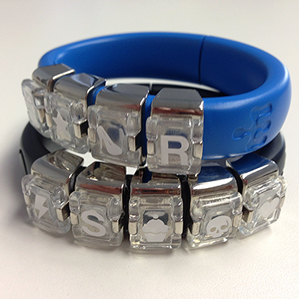A Smart Wristband with Swappable Parts
A Montreal-based startup called Mighty Cast is working on an electronic bracelet to which modular charms can add new functionality. It hopes to start selling it for about $50 later this year.

The Nex Band will be a chunky-looking wristband containing basic electronic components—a microcontroller, a vibration motor, a low-energy Bluetooth radio, and a battery that will last two to four days, depending on how much you use it. The wristband will be sold with a single working mod that can do things like alert you to new text messages, incoming phone calls, or social-network updates.
Additional mods, which the company says will cost $7 to $10, will range in functionality, with some containing additional hardware for things like gesture recognition and activity tracking. Others could be more whimsical—for example, letting users add new powers and characters in mobile games.
The computerized bracelet shows how far companies are willing to stretch to differentiate themselves in the nascent market for wearable gadgets, where form and function are still hotly debated. It also offers a peek at where some wearable devices—and, more generally, consumer electronics—may head as companies experiment with ways to let consumers control the look and functionality of the technology they carry and wear. Customization is becoming easier as electronic components get smaller and cheaper, and some big companies are experimenting with modular devices. Google, for example, is building a modular smartphone through an effort called Project Ara.
The Nex Band might also assess the interest of a younger audience. Adelman says the device will be aimed initially at the tween and teen markets, with features that let users send secret messages to friends by way of blinking LEDs. Each mod will contain, at a minimum, a unique identification number and a multicolored LED. When you snap a mod onto the band, the band will read that ID number and relay it to a remote server via an app on your smartphone to get instructions about how many people have owned it, how far it has traveled, and what its functions are.
Mighty Cast has built prototypes and hopes to offer the Nex Band to developers starting in June, and to consumers late this year. The band will be cheaper than wrist-worn activity trackers such as the Fitbit, Nike’s Fuelband, or Jawbone’s Up, and it will be compatible with the iPhone and Android smartphones. “It gives power to consumers to customize their wearable both on the inside and the outside for a fraction of the cost,” says Adam Adelman, Mighty Cast’s cofounder and CEO.
Adelman showed me a demonstration during an interview over Skype. He held up a circuit board with all the components that will be shoved into the band, and plugged a mod into it, triggering a congratulatory notification in an app on his iPhone screen and changing the graphics in a game on his phone from 2-D to 3-D.
Sabine Seymour, director of the Fashionable Technology Lab at the Parsons school of design, is skeptical that people will want Mighty Cast’s modular technology, at least in its current form. The market for bracelet-like wearable gadgets seems oversaturated already, she says. But Adelman hopes to extend the technology beyond just the wristband to other items like action figures, accessories, or a fridge and its contents. “We’ve got one suggestion that would be really neat, for a wine rack,” he says.
Keep Reading
Most Popular
Large language models can do jaw-dropping things. But nobody knows exactly why.
And that's a problem. Figuring it out is one of the biggest scientific puzzles of our time and a crucial step towards controlling more powerful future models.
The problem with plug-in hybrids? Their drivers.
Plug-in hybrids are often sold as a transition to EVs, but new data from Europe shows we’re still underestimating the emissions they produce.
Google DeepMind’s new generative model makes Super Mario–like games from scratch
Genie learns how to control games by watching hours and hours of video. It could help train next-gen robots too.
How scientists traced a mysterious covid case back to six toilets
When wastewater surveillance turns into a hunt for a single infected individual, the ethics get tricky.
Stay connected
Get the latest updates from
MIT Technology Review
Discover special offers, top stories, upcoming events, and more.